
Grade 10 | Lesson 21
Dean of Students: dean@theschools.com
Tech Services: tech@theschools.com

Grade 10 | Lesson 21
Dean of Students: dean@theschools.com
Tech Services: tech@theschools.com
Science
Lesson Overview
Modifying the Living World
• Selective Breeding and Hybridization
• Mutations
• Genetic Engineering
• The New Human Genetics
You're a Scientist
![]()
Modifying the Living World
One of the most complex questions facing scientists, consumers and philosophers today is that of selective breeding and human genetic engineering. Some aspects of this conversation are still science fiction, but more and more, our technologies are allowing us to modify the living world in tremendous ways. You'll explore some of the questions and issues related to these practices in this lesson
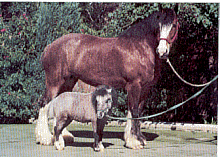 Selective Breeding and Hybridization
Selective Breeding and Hybridization
Farmers and ranchers throughout the world have long tried to improve the organisms with which they work. By selecting the most productive plants or animals to produce the next generation, people have found that the productivity of a domesticated species can gradually be increased. Such an increase in productivity results form using breeding strategies such as selective breeding and two special forms of selective breeding: inbreeding and hybridization.
The oldest and most obvious way of improving a species is by selective breeding, or selecting a few individuals to serve as parents for the next generation. By crossing only those individual plants or animals that have a desired characteristic, the breeder can improve the yield of a crop plant, increase the milk production of cattle, or develop flowers of a particular color. Most present-day crop plants were first developed by selective breeding. Luther Burbank of California (1849-1926) was perhaps the world's foremost selective breeder. Burbank produced more than 250 new varieties of fruit by selective breeding, but his work also extended to other plants, including the daisy and the famous Burbank Potato.
One of the most useful of the breeder's techniques is hybridization, a cross between dissimilar individuals. Hybridization often involves crossing members of different (but related) species. Hybrids, the individuals produced by such crosses, are often hardier than either of the parents. This phenomenon is known as hybrid vigor. All breeds of corn that are grown commercially are hybrids, and every year corn breeders produce new hybrids that combine such basic characteristics as disease resistance, yield per acre, and nutritional value. Modern hybrid corn produces as much as ten times the crop per acre of older varieties of corn.
Research It!
What are some common cross bread and hybrid products that we consume all the time?
Mutations
A useful as selective breeding is, it is confined to characteristics that already exist in the population. But as you may recall, mutations, which are inheritable changes in DNA, can sometimes produce organisms with new characteristics. If the new characteristics are desirable, breeders can use selective breeding to produce an entire population possessing these characteristics.
Of course, a breeder may not want to wait for a beneficial mutation to appear naturally. In such a case, a breeder may decide to artificially increase the chances of mutations occurring in a group of organisms. This can be done with agents or substances known as mutagens.
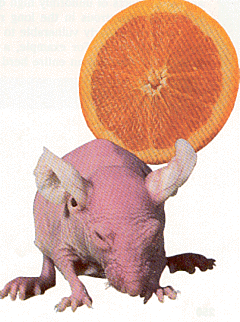
Seedless oranges and hairless mice are the result of mutations.
Mutagens, which include radiation and chemicals, cause mutations. Many mutations are harmful; but with luck and perseverance, a few mutants (individuals with mutations) with desirable characteristics not found in the original population may be produced.
Mutagenesis, or using mutagens to increase the mutation rate, is particularly useful with bacteria. Their small size enables millions of organisms to undergo mutagenesis at the same time, thereby increasing the chances of producing a useful mutant. Using this technique, scientists have been able to develop hundreds of useful bacterial strains. It has even been possible to produce bacteria that can digest oil and are thus useful in cleaning up oil spills.
Genetic Engineering
In recent years molecular biologists have developed a powerful new set of techniques that affect DNA directly. For the first time biologists can engineer a set of genetic changes directly into an organism's DNA. Appropriately enough, this new form of manipulation is called genetic engineering.
Imagine for a moment the tools you would need to take a gene from one organism and place it into another. First, you would need a way to carefully cut the DNA containing the gene away from the genes surrounding it. Second, you would have to find a way to combine that gene with a piece of DNA form the recipient organism; that is, the organism that will receive the DNA. Third, you would have to insert the combined DNA into the new organism. Finally, it would be useful to have a way to read the sequences of nucleotide bases in the gene in order to analyze the genes that you are manipulating. Each of these tools is now available, making it possible to insert a gene from one organism into another.
Genes can be cut at specific DNA sequences by proteins known as restriction enzymes. Many thousands of different kinds of restriction enzymes are known, and each one "recognizes" and cuts DNA at a particular sequence. Each one of the restriction enzymes shown "recognizes" a site of four to six nucleotide pairs and then makes a cut across both strands of DNA. The accuracy of these enzymes is breathtaking. They will not cut any sequence other than the one they recognize, even if five out of six bases are identical to their recognition site. Restriction enzymes make it possible to cut DNA into fragments that can be isolated, separated, and analyzed.
However, DNA fragments cannot function all by themselves. They must become part of the genetic material of living cells before the gene they contain can be activated. In the second step of genetic engineering, DNA fragments are made into part of the recipient cell's genetic material. This is done by combining DNA fragments with DNA from the recipient cell.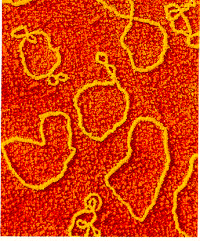
For example, DNA fragments may be combined with bacterial DNA so that they can later be inserted into a bacterial cell. Bacteria often contain small circular DNA molecules known as plasmids in addition to their chromosomes. These plasmids can be removed from bacterial cells and cut with the same restriction enzyme used to produce the DNA fragments. The cuts made by the restriction enzyme produce matching "sticky ends" on the DNA fragments and the cut plasmids. These sticky ends are the sites at which a DNA fragment and a plasmid can be joined end to end, thereby forming a new plasmid that contains a piece of foreign DNA. The combined DNA formed by fusing a DNA fragment and a plasmid consists of parts from different kinds of organisms. In genetic engineering, molecules of combined DNA are known as chimeras because they are produced by combining DNA from different species. Combined DNA is also known as recombinant DNA, since DNA from two sources has been recombined to produce it.
In the first two steps of genetic engineering, DNA fragments containing the desired gene are obtained and then inserted into DNA that has been removed form the recipient cell, thereby producing recombinant DNA. But how is this DNA put back into living cells?
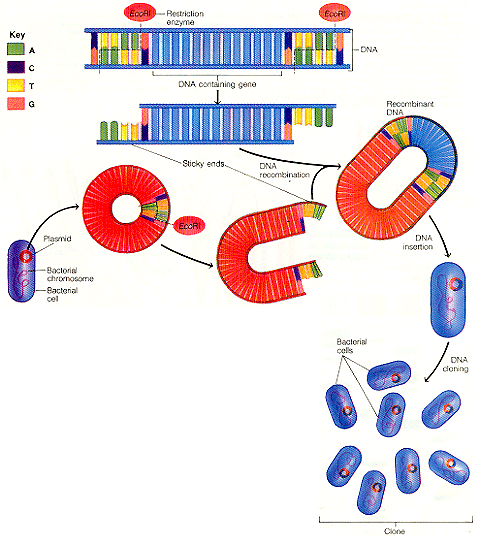
It is easiest to insert DNA into bacterial cells. The recombinant DNA is mixed in with millions of bacteria suspended in a dense salt solution. After a few minutes, several bacteria will take up the DNA. These bacteria can then be isolated and grown into large colonies that contain the recombinant DNA. The technical term for a large number of cells frown from a single cell is clone, and so this technique is sometimes known as DNA cloning.
Using different techniques, recombinant DNA can be inserted into cells other than bacteria - for example, cells from yeasts, animals and plants. These techniques include microinjection with a glass needle, fusion with plasmid-like DNA, and a new procedure in which DNA is attached to fine wirelike pellets that are then shot into cells with a microscopic gun.
Sequencing a piece of DNA, or reading the sequence of DNA bases along its length, is now very common. Only one of the two strands of the DNA double helix is used in the process of DNA sequencing. However, many copies of this one strand are needed. These multiple copies can be produced through the process of DNA cloning. In DNA sequencing, a radioactive label (in form of a radioactive phosphorus atom) is added to single-stranded DNA. The DNA is divided into four groups that undergo different chemical treatments. The chemical treatments break the DNA into pieces that when separated reveal the positions of the bases on the original stand. The DNA pieces are separated by an electrical field in a process called electrophoresis (ee-lehk-troh-fuh-REE-sihs).
The New Human Genetics
The great complexity of the human genome ensures that no individual is exactly like any other. In the last three years, medical researchers have used this biological fact to add a powerful new tool to criminal investigations. The tool is known as DNA fingerprinting. DNA fingerprinting takes advantage of the fact that large portions of the human genome are made up of repeated sequences of varying lengths that do not code for proteins. It has turned out that individuals may have completely different numbers of these repeated units between actual working genes. You may have 15 repeated units between two genes; the person sitting next you might have 6 repeats between the same two genes; and someone else may have 33.
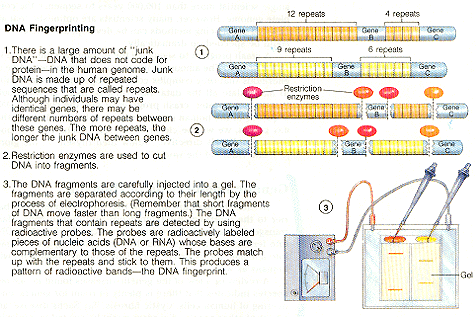
Here's how DNA fingerprinting works: A small sample of human DNA is cut with a restriction enzyme. The resulting fragments are separated by size through the process of electrophoresis. Fragments that contain the repeats are then labeled with DNA "probe," which binds to the DNA sequence of the repeats. This produces a series of bands that by their position show the lengths of the fragments containing the repeats. If enough combinations of restriction enzymes and DNA probes are used, a pattern of bands is produced that can be distinguished from the pattern of any other individual in the world.
DNA samples can be obtained from blood, sperm, and even hair strands with small pieces of tissue at the base. It is clear that DNA fingerprinting will be useful in solving crimes. Several rape suspects have already been convicted in the United States and Great Britain because of DNA fingerprinting showed that their DNA patterns matched blood or sperm samples recovered from their victims. And in at least one case, a wrongly accused person has been set free.
Because humans are animals, too, there is no technical barrier to the insertion of foreign genes into human cells. Many transgenic mammals have been produced by injecting DNA into fertilized ova (eggs) and then transplanting the ova back into a female reproductive tract. This strategy could work with humans as well.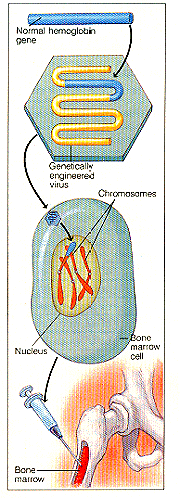
A review of a few of the genetic diseases found in our own species indicates that there is plenty of room for genetic engineering of human cells. Cystic fibrosis, Tay-Sachs disease, and a host of other genetic disorders might be treated by replacing defective genes. The genes for a polypeptide in human hemoglobin have already been inserted into bone marrow cells of mice, suggesting that it might be possible to treat human diseases like sickle cell anemia in the same way.
Despite these possibilities, there are problems, risks, and doubts that have persuaded many scientists that the time is not yet right to carry out these procedures on human beings. Of course it would be marvelous to be able to cure hemophilia or other genetic diseases. But could we be sure that experimentation on humans would involve only diseases? If human cells can be manipulated in this way, should we try to engineer taller people or change their eye color, hair texture, sex, blood type, ear shape? What will happen if we gain the opportunity to design our bodies? What will be the consequences if we develop the ability to "clone" ourselves by making identical genetic copies of our own cells? These are questions that science will rapidly force us to come to grips with.
If we acquire the ability to alter ourselves, we shall also acquire awesome responsibilities. How shall we decide which genes should be transplanted, altered, or redesigned? Who should determine whether experiments with genetic engineering should be done? Scientists? A government agency? The local community?
The purpose of science is to gain a better understanding of the nature of life. The more we understand life, the m ore we shall be able to manipulate it. As our power over nature increases, our society shall have to learn to use wisely the tools that science has given us. And we shall have to develop a thoughtful and ethical consensus of what should and should not be done with the human genome. Scientists alone should not be expected to assume all of the responsibility for these decisions. Society in its entirety should have to deal with these questions. To do anything less would be to lose control of our most precious gifts: our intellect and our humanity.
Research It!
How are we using our new tools of genetic engineering to make transplants more accessible and easier for the people who need them?
![]()
You're a Scientist
Choose one of the questions posed regarding human genetic engineering and explore how you would answer that question. Using a Venn Diagram brainstorm the various different points and counterpoints that someone could make. Can you come to a definitive conclusion?